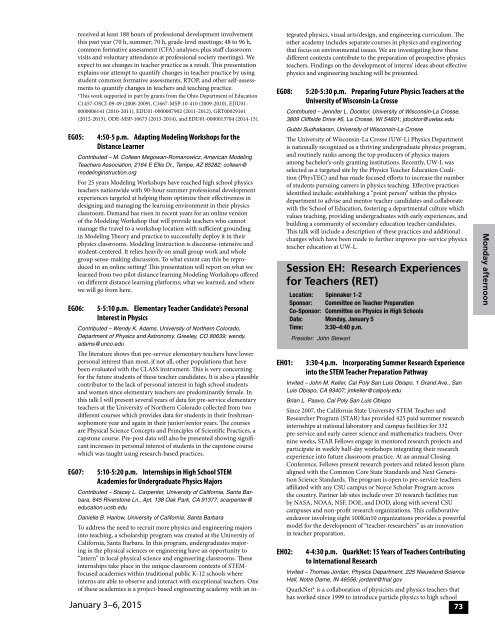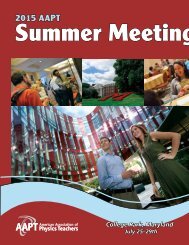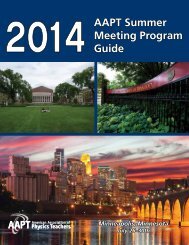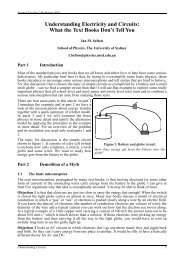final-program-12-23-14-3
final-program-12-23-14-3
final-program-12-23-14-3
Create successful ePaper yourself
Turn your PDF publications into a flip-book with our unique Google optimized e-Paper software.
eceived at least 188 hours of professional development involvement<br />
this past year (70 h, summer; 70 h, grade-level meetings; 48 to 96 h,<br />
common formative assessment (CFA) analyses; plus staff classroom<br />
visits and voluntary attendance at professional society meetings). We<br />
expect to see changes in teacher practice as a result. This presentation<br />
explains our attempt to quantify changes in teacher practice by using<br />
student common formative assessments, RTOP, and other self-assessments<br />
to quantify changes in teachers and teaching practice.<br />
*This work supported in part by grants from the Ohio Department of Education<br />
C<strong>14</strong>57-OSCI-09-49 (2008-2009), C1667-MSP-10-410 (2009-2010), EDU01-<br />
0000006<strong>14</strong>1 (2010-2011), EDU01-0000007902 (2011-20<strong>12</strong>), GRT00029161<br />
(20<strong>12</strong>-2013), ODE-MSP-10673 (2013-20<strong>14</strong>), and EDU01-0000013704 (20<strong>14</strong>-15).<br />
EG05: 4:50-5 p.m. Adapting Modeling Workshops for the<br />
Distance Learner<br />
Contributed – M. Colleen Megowan-Romanowicz, American Modeling<br />
Teachers Association, 2164 E Ellis Dr., Tempe, AZ 85282; colleen@<br />
modelinginstruction.org<br />
For 25 years Modeling Workshops have reached high school physics<br />
teachers nationwide with 90-hour summer professional development<br />
experiences targeted at helping them optimize their effectiveness in<br />
designing and managing the learning environment in their physics<br />
classroom. Demand has risen in recent years for an online version<br />
of the Modeling Workshop that will provide teachers who cannot<br />
manage the travel to a workshop location with sufficient grounding<br />
in Modeling Theory and practice to successfully deploy it in their<br />
physics classrooms. Modeling Instruction is discourse-intensive and<br />
student-centered. It relies heavily on small group work and whole<br />
group sense-making discussion. To what extent can this be reproduced<br />
in an online setting This presentation will report on what we<br />
learned from two pilot distance learning Modeling Workshops offered<br />
on different distance learning platforms; what we learned, and where<br />
we will go from here.<br />
EG06: 5-5:10 p.m. Elementary Teacher Candidate’s Personal<br />
Interest in Physics<br />
Contributed – Wendy K. Adams, University of Northern Colorado,<br />
Department of Physics and Astronomy, Greeley, CO 80639; wendy.<br />
adams@unco.edu<br />
The literature shows that pre-service elementary teachers have lower<br />
personal interest than most, if not all, other populations that have<br />
been evaluated with the CLASS instrument. This is very concerning<br />
for the future students of these teacher candidates. It is also a plausible<br />
contributor to the lack of personal interest in high school students<br />
and women since elementary teachers are predominantly female. In<br />
this talk I will present several years of data for pre-service elementary<br />
teachers at the University of Northern Colorado collected from two<br />
different courses which provides data for students in their freshmansophomore<br />
year and again in their junior/senior years. The courses<br />
are Physical Science Concepts and Principles of Scientific Practices, a<br />
capstone course. Pre-post data will also be presented showing significant<br />
increases in personal interest of students in the capstone course<br />
which was taught using research-based practices.<br />
EG07: 5:10-5:20 p.m. Internships in High School STEM<br />
Academies for Undergraduate Physics Majors<br />
January 3–6, 2015<br />
EG08:<br />
Contributed – Stacey L. Carpenter, University of California, Santa Barbara,<br />
645 Riverstone Ln., Apt. 138 Oak Park, CA 91377; scarpenter@<br />
education.ucsb.edu<br />
Danielle B. Harlow, University of California, Santa Barbara<br />
To address the need to recruit more physics and engineering majors<br />
into teaching, a scholarship <strong>program</strong> was created at the University of<br />
California, Santa Barbara. In this <strong>program</strong>, undergraduates majoring<br />
in the physical sciences or engineering have an opportunity to<br />
“intern” in local physical science and engineering classrooms. These<br />
internships take place in the unique classroom contexts of STEMfocused<br />
academies within traditional public K-<strong>12</strong> schools where<br />
interns are able to observe and interact with exceptional teachers. One<br />
of these academies is a project-based engineering academy with an integrated<br />
physics, visual arts/design, and engineering curriculum. The<br />
other academy includes separate courses in physics and engineering<br />
that focus on environmental issues. We are investigating how these<br />
different contexts contribute to the preparation of prospective physics<br />
teachers. Findings on the development of interns’ ideas about effective<br />
physics and engineering teaching will be presented.<br />
5:20-5:30 p.m. Preparing Future Physics Teachers at the<br />
University of Wisconsin-La Crosse<br />
Contributed – Jennifer L. Docktor, University of Wisconsin-La Crosse,<br />
3809 Cliffside Drive #6, La Crosse, WI 54601; jdocktor@uwlax.edu<br />
Gubbi Sudhakaran, University of Wisconsin-La Crosse<br />
The University of Wisconsin-La Crosse (UW-L) Physics Department<br />
is nationally recognized as a thriving undergraduate physics <strong>program</strong>,<br />
and routinely ranks among the top producers of physics majors<br />
among bachelor’s-only granting institutions. Recently, UW-L was<br />
selected as a targeted site by the Physics Teacher Education Coalition<br />
(PhysTEC) and has made focused efforts to increase the number<br />
of students pursuing careers in physics teaching. Effective practices<br />
identified include: establishing a “point person” within the physics<br />
department to advise and mentor teacher candidates and collaborate<br />
with the School of Education, fostering a departmental culture which<br />
values teaching, providing undergraduates with early experiences, and<br />
building a community of secondary education teacher candidates.<br />
This talk will include a description of these practices and additional<br />
changes which have been made to further improve pre-service physics<br />
teacher education at UW-L.<br />
EH01:<br />
Session EH: Research Experiences<br />
for Teachers (RET)<br />
Location: Spinnaker 1-2<br />
Sponsor: Committee on Teacher Preparation<br />
Co-Sponsor: Committee on Physics in High Schools<br />
Date: Monday, January 5<br />
Time: 3:30–4:40 p.m.<br />
Presider: John Stewart<br />
3:30-4 p.m. Incorporating Summer Research Experience<br />
into the STEM Teacher Preparation Pathway<br />
Invited – John M. Keller, Cal Poly San Luis Obispo, 1 Grand Ave., San<br />
Luis Obispo, CA 93407; jmkeller@calpoly.edu<br />
Brian L. Paavo, Cal Poly San Luis Obispo<br />
Since 2007, the California State University STEM Teacher and<br />
Researcher Program (STAR) has provided 425 paid summer research<br />
internships at national laboratory and campus facilities for 332<br />
pre-service and early career science and mathematics teachers. Over<br />
nine weeks, STAR Fellows engage in mentored research projects and<br />
participate in weekly half-day workshops integrating their research<br />
experience into future classroom practice. At an annual Closing<br />
Conference, Fellows present research posters and related lesson plans<br />
aligned with the Common Core State Standards and Next Generation<br />
Science Standards. The <strong>program</strong> is open to pre-service teachers<br />
affiliated with any CSU campus or Noyce Scholar Program across<br />
the country. Partner lab sites include over 20 research facilities run<br />
by NASA, NOAA, NSF, DOE, and DOD, along with several CSU<br />
campuses and non-profit research organizations. This collaborative<br />
endeavor involving eight 100Kin10 organizations provides a powerful<br />
model for the development of “teacher-researchers” as an innovation<br />
in teacher preparation.<br />
EH02:<br />
4-4:30 p.m. QuarkNet: 15 Years of Teachers Contributing<br />
to International Research<br />
Invited – Thomas Jordan, Physics Department, 225 Nieuwland Science<br />
Hall, Notre Dame, IN 46556; jordant@fnal.gov<br />
QuarkNet* is a collaboration of physicists and physics teachers that<br />
has worked since 1999 to introduce particle physics to high school<br />
73<br />
Monday afternoon






